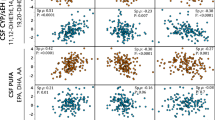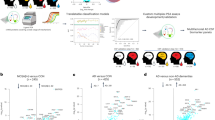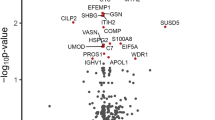Abstract
Although some insights into the etiology of schizophrenia have been gained, an understanding of the illness at the molecular level remains elusive. Recent advances in proteomic profiling offer great promise for the discovery of markers underlying pathophysiology of diseases. In the present study, we employed two high-throughput proteomic techniques together with traditional methods to investigate cerebrospinal fluid (CSF), brain and peripheral tissues (liver, red blood cells and serum) of schizophrenia patients in an attempt to identify peripheral/surrogate disease markers. The cohorts used to investigate each tissue were largely independent, although some CSF and serum samples were collected from the same patient. To address the major confounding factor of antipsychotic drug treatment, we also included a large cohort of first-onset drug-naive patients. Apolipoprotein A1 (apoA1) showed a significant decrease in expression in schizophrenia patients compared to controls in all five tissues examined. Specifically, using SELDI–TOF mass spectrometry, apoA1 was found decreased in CSF from schizophrenia patients (−35%, P=0.00001) and, using 2D-DIGE, apoA1 was also found downregulated in liver (−30%, P=0.02) and RBCs (−60%, P=0.003). Furthermore, we found a significant reduction of apoA1 in sera of first-onset drug-naive schizophrenia patients using enzyme-linked immunosorbent assay (−18%, P=0.00008) and in two investigations of post-mortem brain tissue using western blot analysis (−35%, P=0.05; −51%, P=0.05). These results show that apoA1 is consistently downregulated in the central nervous system as well as peripheral tissues of schizophrenia patients and may be linked to the underlying disease mechanism.
This is a preview of subscription content, access via your institution
Access options
Subscribe to this journal
Receive 12 print issues and online access
$259.00 per year
only $21.58 per issue
Buy this article
- Purchase on Springer Link
- Instant access to full article PDF
Prices may be subject to local taxes which are calculated during checkout





Similar content being viewed by others
References
Jablensky A, Sartorius N, Ernberg G, Anker M, Korten A, Cooper JE et al. Schizophrenia: manifestations, incidence and course in different cultures. A World Health Organization ten-country study. Psychol Med Monogr Suppl 1992; 20: 1–97.
Owen MJ, Williams NM, O'Donovan MC . The molecular genetics of schizophrenia: new findings promise new insights. Mol Psychiatry 2004; 9: 14–27.
Flyckt L, Borg J, Borg K, Ansved T, Edman G, Bjerkenstedt L et al. Muscle biopsy, macro EMG, and clinical characteristics in patients with schizophrenia. Biol Psychiatry 2000; 47: 991–999.
Schwarz MJ, Muller N, Riedel M, Ackenheil M . The Th2-hypothesis of schizophrenia: a strategy to identify a subgroup of schizophrenia caused by immune mechanisms. Med Hypotheses 2001; 56: 483–486.
Haupt DW, Newcomer JW . Abnormalities in glucose regulation associated with mental illness and treatment. J Psychosom Res 2002; 53: 925–933.
Ryan MC, Collins P, Thakore JH . Impaired fasting glucose tolerance in first-episode, drug-naive patients with schizophrenia. Am J Psychiatry 2003; 160: 284–289.
Heiskanen T, Niskanen L, Lyytikainen R, Saarinen PI, Hintikka J . Metabolic syndrome in patients with schizophrenia. J Clin Psychiatry 2003; 64: 575–579.
Kirkegaard C, Faber J . The role of thyroid hormones in depression. Eur J Endocrinol 1998; 138: 1–9.
Baumgartner A, Pietzcker A, Gaebel W . The hypothalamic-pituitary-thyroid axis in patients with schizophrenia. Schizophr Res 2000; 44: 233–243.
Prabakaran S, Swatton JE, Ryan MM, Huffaker SJ, Huang JT, Griffin JL et al. Mitochondrial dysfunction in schizophrenia: evidence for compromised brain metabolism and oxidative stress. Mol Psychiatry 2004; 9: 643, 684–697.
Swatton JE, Prabakaran S, Karp NA, Lilley KS, Bahn S . Protein profiling of human postmortem brain using 2-dimensional fluorescence difference gel electrophoresis (2-D DIGE). Mol Psychiatry 2004; 9: 128–143.
Huang JT, Leweke FM, Oxley D, Wang L, Harris N, Koethe D et al. Disease biomarkers in cerebrospinal fluid of patients with first-onset psychosis. PLoS Med 2006; 3: e428.
Mero N, Van Tol A, Scheek LM, Van Gent T, Labeur C, Rosseneu M et al. Decreased postprandial high density lipoprotein cholesterol and apolipoproteins A-I and E in normolipidemic smoking men: relations with lipid transfer proteins and LCAT activities. J Lipid Res 1998; 39: 1493–1502.
Lewis GF . Determinants of plasma HDL concentrations and reverse cholesterol transport. Curr Opin Cardiol 2006; 21: 345–352.
Mimmack ML, Ryan M, Baba H, Navarro-Ruiz J, Iritani S, Faull RL et al. Gene expression analysis in schizophrenia: reproducible up-regulation of several members of the apolipoprotein L family located in a high-susceptibility locus for schizophrenia on chromosome 22. Proc Natl Acad Sci USA 2002; 99: 4680–4685.
Thomas EA, Dean B, Scarr E, Copolov D, Sutcliffe JG . Differences in neuroanatomical sites of apoD elevation discriminate between schizophrenia and bipolar disorder. Mol Psychiatry 2003; 8: 167–175.
Yang Y, Wan C, Li H, Zhu H, La Y, Xi Z et al. Altered levels of acute phase proteins in the plasma of patients with schizophrenia. Anal Chem 2006; 78: 3571–3576.
Thomas EA, George RC, Danielson PE, Nelson PA, Warren AJ, Lo D et al. Antipsychotic drug treatment alters expression of mRNAs encoding lipid metabolism-related proteins. Mol Psychiatry 2003; 8: 950, 983–993.
Reiss AB . Cholesterol and apolipoprotein E in Alzheimer's disease. Am J Alzheimers Dis Other Demen 2005; 20: 91–96.
Bossy-Wetzel E, Schwarzenbacher R, Lipton SA . Molecular pathways to neurodegeneration. Nat Med 2004; 10 (Suppl): S2–S9.
Bossy-Wetzel E, Talantova MV, Lee WD, Scholzke MN, Harrop A, Mathews E et al. Crosstalk between nitric oxide and zinc pathways to neuronal cell death involving mitochondrial dysfunction and p38-activated K+ channels. Neuron 2004; 41: 351–365.
Onyango IG, Khan SM . Oxidative stress, mitochondrial dysfunction, and stress signaling in Alzheimer's disease. Curr Alzheimer Res 2006; 3: 339–349.
Torrey EF, Yolken RH . The schizophrenia-rheumatoid arthritis connection: infectious, immune, or both? Brain Behav Immun 2001; 15: 401–410.
Yao JK, Thomas EA, Reddy RD, Keshavan MS . Association of plasma apolipoproteins D with RBC membrane arachidonic acid levels in schizophrenia. Schizophr Res 2005; 72: 259–266.
Holmes E, Tsang TM, Huang JT, Leweke FM, Koethe D, Gerth CW et al. Metabolic profiling of CSF: evidence that early intervention may impact on disease progression and outcome in schizophrenia. PLoS Med 2006; 3: e327.
Acknowledgements
This research was supported by the Stanley Medical Research Institute (SMRI) and the donations of the Stanley brain collection courtesy of Drs Michael B Knable, E Fuller Torrey and Robert H Yolken. We also thank The Henry Smith Charity for financial support. We are especially grateful to Dr Maree Webster for providing tissues from the Stanley Brain Collection. We thank all other members of the Bahn laboratory for discussions, help and encouragement. Most of all, we thank all patients and healthy controls for their selfless donation of samples used in this study. SB holds a NARSAD Essel Independent Investigator Fellowship.
Author information
Authors and Affiliations
Corresponding author
Additional information
Supplementary Information accompanies the paper on the Molecular Psychiatry website (http://www.nature.com/mp)
Supplementary information
Rights and permissions
About this article
Cite this article
Huang, JJ., Wang, L., Prabakaran, S. et al. Independent protein-profiling studies show a decrease in apolipoprotein A1 levels in schizophrenia CSF, brain and peripheral tissues. Mol Psychiatry 13, 1118–1128 (2008). https://doi.org/10.1038/sj.mp.4002108
Received:
Revised:
Accepted:
Published:
Issue Date:
DOI: https://doi.org/10.1038/sj.mp.4002108
Keywords
This article is cited by
-
Biomarkers in the cerebrospinal fluid of patients with psychotic disorders compared to healthy controls: a systematic review and meta-analysis
Molecular Psychiatry (2023)
-
Association between clinical symptoms and apolipoprotein A1 or apolipoprotein B levels is regulated by apolipoprotein E variant rs429358 in patients with chronic schizophrenia
Annals of General Psychiatry (2021)
-
The proteomic architecture of schizophrenia iPSC-derived cerebral organoids reveals alterations in GWAS and neuronal development factors
Translational Psychiatry (2021)
-
Endothelial dysfunction in neuroprogressive disorders—causes and suggested treatments
BMC Medicine (2020)
-
Schizophrenia-risk and urban birth are associated with proteomic changes in neonatal dried blood spots
Translational Psychiatry (2017)



